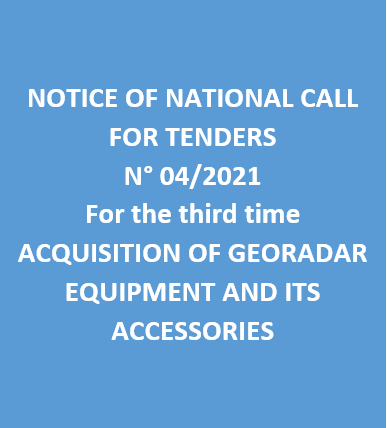| Annual program and technical progress report |
-

Activity Report 2023
-

Technical Program 2024
|
| Geocatalogue |

|
| Invitation to
tender |
-

REALIZATION OF THE TRAINING PLAN FOR THE YEAR 2022
-

ACQUISITION OF TWO SERVICE CARS
-

ACQUISITION OF GEORADAR EQUIPMENT AND ITS ACCESSORIES
|
|
Invest in Tunisia |

|
|
|
|
|
::
Documentation and Editions
>>
Research library
|
| |
|
[
Search by author
]
[
Search keyword
]
[
Search by index
]
[
Search by category
]
|
title of the reference :
|
Etude sur les gisements de manganèse du Sud Tunisien (Jebel Oum Ali, Hachichina, Batoum, Naïmia).
|
|
Publication Date:
|
1947
|
|
Author :
|
Volpeliere P.
|
|
Catalogue type :
|
Livre
|
|
Catalogue reference :
|
Etude sur les gisements de manganèse du Sud Tunisien (Jebel Oum Ali, Hachichina, Batoum, Naïmia). Le gisement de manganèse du Sud Tunisien a été découvert en 1902, ce gisement se situe dans la chaîne du Cherb orienté Ouest-Est, qui sépare le Chott fedjedj au Sud de la plaine alluvionnaire du Segui au Nord. Les points minéralisés dans cette région sont le Jebel Oum Ali où la minéralisation est faible, le groupe de l'Hachichina, le Jebel Batoum dont le gisement est très étendu et d'une extrême diffusion, le groupe de Jebel Naima et le groupe du Jebel Lefaia.
ressource minérale ; manganèse ; plaine ; massif ; faille ; alluvion ; Quaternaire ; marne ; Maestrichtien ; grès ; Campanien ; synclinal ; calcaire ; minerai ; anticlinal ; affleurement ; Formation ; Tunisie ; Tunisie Sud Orientale ; Chott El Fejjaj ; Ain kerma ; J. Oum Ali ; Hachichina ; Batoum ; Naimia Volpeliere P. Hydrogéologie
|
|
Indexation decimale :
|
Hydrogéologie
|
|
Keywords :
|
ressource minérale ; manganèse ; plaine ; massif ; faille ; alluvion ; Quaternaire ; marne ; Maestrichtien ; grès ; Campanien ; synclinal ; calcaire ; minerai ; anticlinal ; affleurement ; Formation ; Tunisie ; Tunisie Sud Orientale ; Chott El Fejjaj ; Ain kerma ; J. Oum Ali ; Hachichina ; Batoum ; Naimia
|
|
Summary :
|
Le gisement de manganèse du Sud Tunisien a été découvert en 1902, ce gisement se situe dans la chaîne du Cherb orienté Ouest-Est, qui sépare le Chott fedjedj au Sud de la plaine alluvionnaire du Segui au Nord. Les points minéralisés dans cette région sont le Jebel Oum Ali où la minéralisation est faible, le groupe de l'Hachichina, le Jebel Batoum dont le gisement est très étendu et d'une extrême diffusion, le groupe de Jebel Naima et le groupe du Jebel Lefaia.
|
|
Exemplaries :
|
RI3945A, RI3945B
|
|
|
|
|
|
|
|



